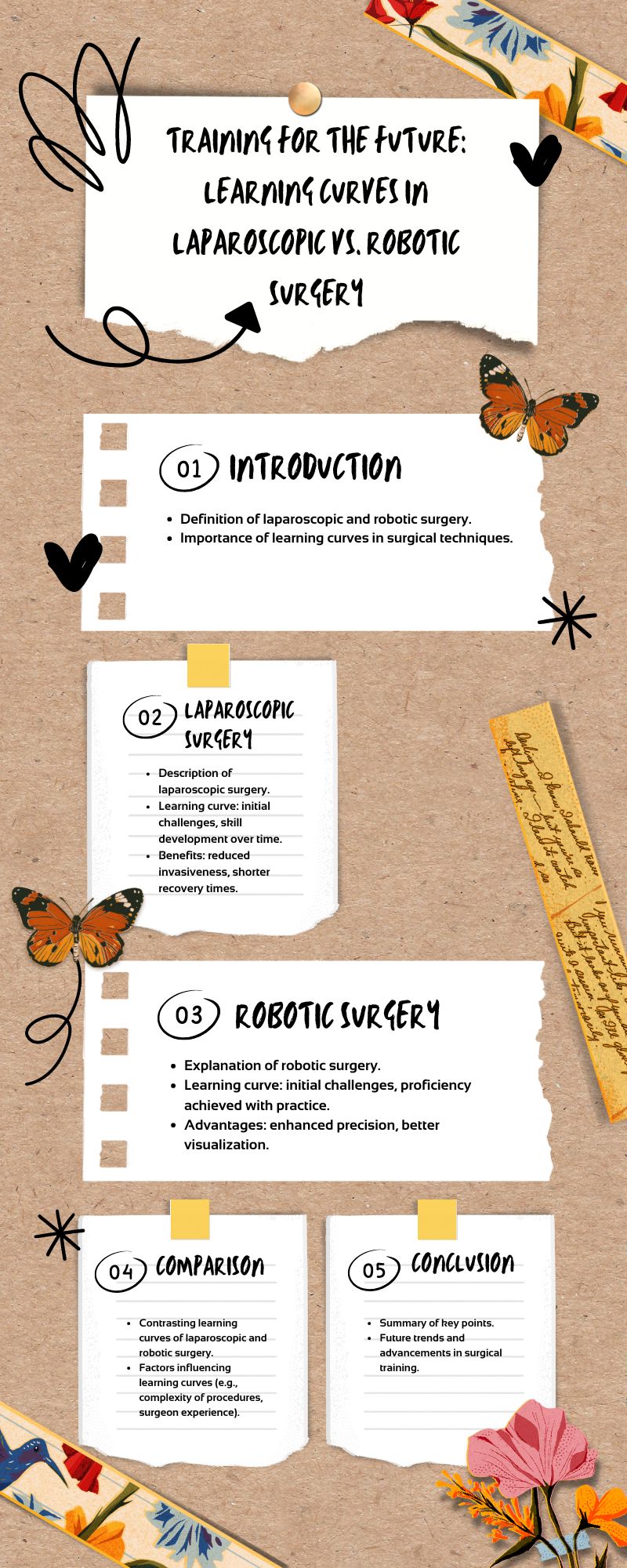Training for the Future: Learning Curves in Laparoscopic vs. Robotic Surgery
Introduction
Surgical techniques have evolved significantly over the past few decades, with laparoscopic and robotic surgeries emerging as advanced alternatives to traditional open surgery. These minimally invasive procedures offer numerous advantages, including reduced pain, shorter hospital stays, and faster recovery times. However, mastering these techniques requires extensive training and experience due to the unique learning curves associated with each approach. In this article, we explore the learning curves of laparoscopic and robotic surgery, comparing the challenges and strategies for training in both disciplines.

Understanding Laparoscopic Surgery
Laparoscopic surgery, also known as minimally invasive surgery, involves making small incisions in the abdomen through which a laparoscope and specialized surgical instruments are inserted. The surgeon views the internal organs on a monitor and performs the procedure with precision and control. While laparoscopic surgery offers numerous benefits, such as reduced scarring and faster recovery, it requires a high level of hand-eye coordination and spatial awareness.
The Learning Curve in Laparoscopic Surgery
The learning curve for laparoscopic surgery is steep, with beginners facing challenges in hand-eye coordination, instrument manipulation, and depth perception. Surgeons must learn to operate in a 2D visual field, which can be disorienting compared to the 3D view in open surgery. Additionally, the use of long, rigid instruments requires a different set of motor skills than those used in traditional surgery.
Training Strategies for Laparoscopic Surgery
To overcome the learning curve in laparoscopic surgery, structured training programs are essential. These programs often include virtual reality simulators, box trainers, and animal or cadaver labs to help surgeons develop the necessary skills in a controlled environment. Mentored proctoring, where experienced surgeons provide guidance and feedback during procedures, is also valuable in accelerating the learning process.
Understanding Robotic Surgery
Robotic surgery, also known as robot-assisted surgery, takes laparoscopic surgery to the next level by using robotic arms controlled by the surgeon from a console. The robotic system provides enhanced dexterity, precision, and range of motion, allowing for more complex procedures to be performed with greater accuracy. Robotic surgery offers several advantages over laparoscopic surgery, including improved ergonomics for the surgeon and a 3D high-definition view of the surgical field.
The Learning Curve in Robotic Surgery
While robotic surgery offers numerous benefits, mastering this technology requires significant training. Surgeons must become proficient in using the console to control the robotic arms, which requires a different skill set than traditional laparoscopic surgery. The learning curve for robotic surgery is often longer than that of laparoscopic surgery due to the complexity of the system and the need to adapt to a new way of operating.
Training Strategies for Robotic Surgery
Training programs for robotic surgery typically involve a combination of virtual reality simulation, hands-on practice with the robotic system, and proctored surgical cases. Surgeons must become familiar with the robotic interface and develop the skills needed to manipulate the robotic arms effectively. Mentorship plays a crucial role in robotic surgery training, with experienced surgeons guiding and supervising less experienced practitioners until they are proficient in using the technology.
Comparing Learning Curves
While both laparoscopic and robotic surgery offer significant benefits, the learning curves for each approach differ. Laparoscopic surgery requires surgeons to adapt to a 2D visual field and develop precise instrument manipulation skills, while robotic surgery requires mastering the robotic interface and hand-eye coordination to control the robotic arms effectively.
Conclusion
In conclusion, training for the future of surgery requires a thorough understanding of the learning curves associated with laparoscopic and robotic surgery. While both approaches offer significant benefits, mastering these techniques requires structured training programs, mentorship, and hands-on practice. By investing in training and education, surgeons can enhance their skills and provide patients with the best possible outcomes in the evolving field of minimally invasive surgery.
Similarly, the exploration of robotic surgery unveils the multifaceted learning process involved in mastering the robotic interface and controlling the robotic arms with precision. The article adeptly compares the distinct learning curves of these two surgical approaches, shedding light on the unique skill sets required for proficiency in each discipline.
With insights gleaned from this comparative analysis, surgeons and trainees alike can gain a deeper understanding of the training regimens essential for success in laparoscopic and robotic surgeries. Armed with this knowledge, they can embark on their surgical journeys with confidence, poised to overcome the challenges and embrace the opportunities presented by these advanced techniques.
Laparoscopic surgery, renowned for its minimally invasive approach, demands a steep learning curve characterized by nuances in hand-eye coordination and instrument manipulation. Surgeons adept in laparoscopic techniques harness structured training programs, including simulation-based modules and mentorship, to navigate this journey towards proficiency.
Conversely, robotic surgery, heralding precision and innovation, requires surgeons to adapt to a new paradigm of operating with robotic arms. Mastery of the robotic interface and intricate hand-eye coordination define the extended learning curve of robotic surgery, underpinned by immersive training modalities and mentorship.
| Older Post | Home | Newer Post |





